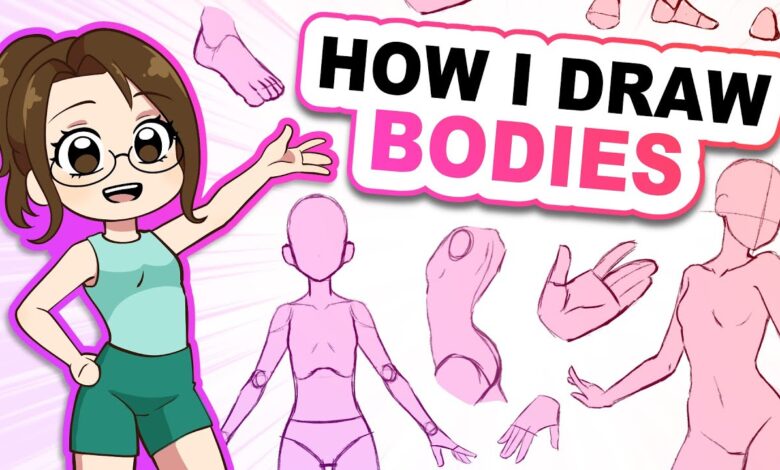Easy Body Drawing Base: A Complete Guide for Beginners

Drawing the human body can be intimidating, especially for beginners who are just starting their artistic journey. Proportions, anatomy, and poses may feel overwhelming at first. However, using an easy body drawing base makes the process much simpler. A base provides a structural guide, helping artists sketch figures with balanced proportions and accurate poses before adding details. Whether you are a beginner or a hobbyist who wants to refine your skills, learning how to use and create body drawing bases is one of the most effective ways to improve.
In this article, we’ll explore the concept of body drawing bases, why they’re important, different methods to create them, and step-by-step tips to practice figure drawing with ease.
What is a Body Drawing Base?

A body drawing base is a simplified sketch or template that acts as the foundation of a human figure. Think of it as the framework upon which details such as muscles, clothing, and facial expressions are added. Instead of drawing the body directly with full detail, artists first create a base to ensure that proportions, balance, and posture look natural.
Bases typically use simple shapes such as circles, ovals, rectangles, and lines to represent body parts. For example:
A circle for the head
Rectangles or ovals for the torso
Lines for arms and legs
Small circles for joints
This step-by-step framework makes it much easier to design figures in different poses without worrying about mistakes early on.
Why Use an Easy Body Drawing Base?
There are many benefits to starting with a drawing base, especially for beginners:
Improved Proportions – Bases help you avoid disproportionate heads, limbs, or torsos.
Faster Sketching – Once you master the technique, you can quickly sketch different poses without hesitation.
Versatility – Bases can be reused or modified for new characters, poses, or clothing designs.
Confidence Booster – Instead of staring at a blank page, having a base gives you a starting point.
Foundation for Style – Whether you prefer realistic, cartoon, or anime-style art, a base can be adjusted to match your style.
Common Types of Body Drawing Bases
Depending on your art goals, you can choose different types of body drawing bases. Here are the most common:
Stick Figure Base
The simplest form of base, made up of straight lines and circles for joints. It’s great for practicing body proportions and dynamic poses.
Geometric Shape Base
Uses ovals, rectangles, and cylinders to represent the torso, arms, and legs. This method helps visualize body volume better than stick figures.
Mannequin Base
This method treats the body like a wooden mannequin, with simplified 3D forms. It’s useful for artists who want more realistic proportions.
Anime/Manga Base
A stylized version with exaggerated features like larger eyes, smaller noses, and slimmer bodies. Anime bases are very popular among beginner artists.
Step-by-Step Guide: How to Draw an Easy Body Drawing Base
Let’s go through a simple process to draw a body base for beginners:
Draw the Head
Start with a circle. Add a vertical line down the middle and a horizontal line across the circle to help with facial symmetry later.
Sketch the Torso
Draw an oval or rectangle shape below the head for the chest. Add another oval below it for the hips. Connect them with a line to represent the spine.
Add Arms and Legs
Use straight lines for the limbs. Mark the joints (shoulders, elbows, knees) with small circles. Keep proportions balanced: arms should reach mid-thigh, and legs should be about half the body’s total height.
Indicate Hands and Feet
For now, use simple shapes—triangles for feet and small ovals for hands.
Refine with Shapes
Thicken the limbs with oval or cylinder shapes to give volume. This step transforms your stick figure into a mannequin-style base.
Adjust the Pose
Experiment with bending lines for arms and legs. Shift the torso to create movement. This makes your figure look more natural and dynamic.
Proportion Guidelines for Easy Bases
Understanding proportion is essential for drawing believable figures. Here are some general rules:
Head-to-Body Ratio: Adults are usually 7–8 heads tall. Children are 4–6 heads tall.
Torso: The torso makes up about 3 heads in length.
Arms: Hands should rest around mid-thigh when extended.
Legs: Longer than the torso, usually around 4 heads in length.
These ratios can be adjusted for different art styles (realistic vs. cartoonish).
Tips for Practicing with Body Drawing Bases
Start with References – Use photos, anatomy books, or pose references to guide your bases.
Practice Daily – Even quick 5–10 minute sketches help train your eye for proportions.
Experiment with Poses – Don’t just stick to standing figures. Try running, jumping, or sitting poses.
Use Digital Tools – Apps like Procreate, Clip Studio Paint, or free 3D mannequin models can help visualize bases.
Keep It Simple – Don’t focus on details at the base stage. Save clothing, hair, and accessories for later.
Digital vs. Traditional Body Drawing Bases
Both traditional and digital methods have unique advantages:
Traditional (pencil & paper): Great for beginners to develop hand control and observation skills.
Digital (tablet & software): Offers layers, easy erasing, and the ability to use pre-made base templates for practice.
Many beginners find digital art less stressful since mistakes can be corrected instantly.
Pre-Made Body Bases: Are They Useful?
Yes! Many artists, especially beginners, use pre-made body drawing bases as practice tools. These are available in sketchbooks, online resources, or art apps. They provide a ready-made structure to practice drawing clothing, hairstyles, and accessories. However, while pre-made bases are helpful, you should also practice creating your own to develop creativity and confidence.
Avoiding Common Mistakes
When practicing with easy body drawing bases, watch out for these mistakes:
Incorrect proportions – Avoid making the head too big or arms too short.
Stiff poses – Don’t keep the figure too straight; add curves and angles for realism.
Overcomplicating – Beginners sometimes add too many details too soon. Focus on structure first.
Ignoring balance – Ensure your figure looks like it can stand or move without falling.
Why an Easy Body Drawing Base is the Key to Improvement
The biggest struggle for beginners is jumping directly into detailed figure drawing without a foundation. This often leads to frustration and discouragement. By starting with an easy body drawing base, you build a framework that simplifies complex anatomy into manageable steps. Over time, this approach will:
Train your eye for proportion
Improve your understanding of anatomy
Allow you to experiment with poses
Build confidence in sketching
With consistent practice, your simple bases will evolve into dynamic, expressive, and detailed human figures.
Conclusion
Learning to draw the human body doesn’t have to be overwhelming. By starting with an easy body drawing base, you create a simple yet powerful structure that makes sketching figures more approachable. Whether you use stick figures, geometric shapes, or mannequin-style bases, the key is to focus on proportion, balance, and pose before adding details.
For beginners, this method not only builds confidence but also opens the door to exploring more advanced techniques in anatomy, shading, and character design. With patience and regular practice, you’ll find that body drawing becomes less about stress and more about creative expression.



